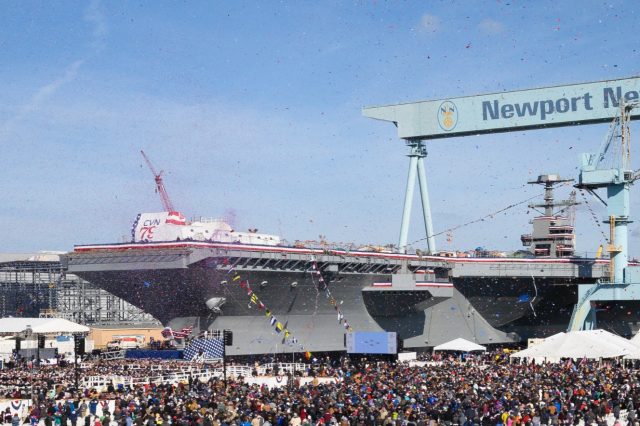US shipbuilder Huntington Ingalls Industries hosted a christening ceremony for the US Navy’s second Ford-class aircraft carrier, the future USS John F. Kennedy (CVN 79), at Newport News, Virginia, on December 7.
John F. Kennedy is slated to replace USS Nimitz (CVN 68), when that ship is decommissioned.
Former NASA Administrator Maj. Gen. Charles F. Bolden, USMC (Ret.), delivered the ceremony’s keynote address. Ambassador Caroline Kennedy, president Kennedy’s daughter, served as the ship’s sponsor and broke a bottle of American sparkling wine against a plate welded to the hull.
“USS John F. Kennedy will carry the legacy of its namesake and the power of our nation,” said Acting Secretary of the Navy Thomas Modly. “The advanced technology and warfighting capabilities this aircraft carrier brings to our global challenges will strengthen our allies and partners, extend our reach against potential adversaries, and further the global mission of our integrated naval force.”
Built by Huntington Ingalls Industries’ Newport News Shipbuilding division, the Gerald R. Ford class incorporates advances in technology, such as a new propulsion system, electric plant, Electromagnetic Aircraft Launch System (EMALS), Advanced Arresting Gear (AAG), machinery control, radars and integrated warfare systems.
At 1,092 feet in length and 100,000 tons, CVN 79 incorporates more than 23 new technologies. These innovations will support a 33% higher sortie generation rate at a significant cost savings, when compared to Nimitz-class carriers. According to the navy, the Gerald R. Ford class also offers a significant reduction—approximately $4 billion per ship—in life cycle operations and support costs compared to the earlier Nimitz class.
USS Gerald R. Ford, the lead ship, was commissioned in 2017 and is yet to achieve operational capability. Reports from earlier this year have indicated that the carrier might not deploy before 2024. As the first ship in a new class and featuring a number of new technologies, the ship is tackling issues related to its weapon elevators, advanced arresting gear (AAG) and the electro-magnetic launch system (EMALS) which is replacing the legacy steam catapults found on Nimitz-class aircraft carriers.



























